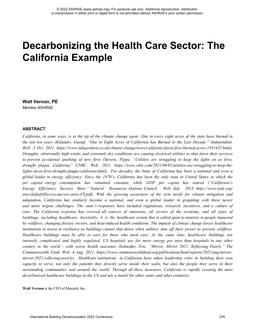Click here to purchase
California, in some ways, is at the tip of the climate change spear. One in every eight acres of the state have burned in the last ten years (Kilander, Gustaf. “One in Eight Acres of California has Burned in the Last Decade.” Independent. Web. 3 Oct. 2021. https://www.independent.co.uk/climate-change/news/california-forest-fires-burned-acres-1931435.html). Droughts, abnormally high winds, and extremely dry conditions are causing electrical utilities to shut down their services to prevent accidental sparking of new fires (Stevens, Pippa. “Utilities are struggling to keep the lights on as fires, drought plague California” CNBC. Web. 2021. https://www.cnbc.com/2021/08/01/utilities-are-struggling-to-keep-the-lights-on-as-fires-drought-plague-california.html). For decades, the State of California has been a national and even a global leader in energy efficiency. Since the 1970’s, California has been the only state in United States in which the per capital energy consumption has remained constant, while GDP per capita has soared (“California’s Energy Efficiency Success Story.” Natural Resources Defense Council. Web. July 2013. https://www.nrdc.org/sites/default/files/ca-success-story-FS.pdf). With the growing awareness of the twin needs for climate mitigation and adaptation, California has similarly become a national, and even a global leader in grappling with these newer and more urgent challenges. The state’s responses have included regulations, research, incentives, and a culture of care. The California response has covered all sources of emissions, all sectors of the economy, and all types of buildings, including healthcare. Inevitably, it is the healthcare system that is called upon to minister to people impacted by wildfires, changing disease vectors, and heat-induced health conditions. The impacts of climate change forces healthcare institutions to invest in resilience as buildings cannot shut down when utilities shut off their power to prevent wildfires. Healthcare buildings must be able to care for those who need care. At the same time, healthcare buildings are intensely complicated and highly regulated. US hospitals use far more energy per area than hospitals in any other country in the world – with worse health outcomes (Schneider, Eric. “Mirror, Mirror 2021: Reflecting Poorly.” The Commonwealth Fund. Web. 4 Aug. 2021. https://www.commonwealthfund.org/publications/fund-reports/2021/aug/mirror-mirror-2021-reflecting-poorly). Healthcare institutions in California have taken leadership roles in building their own capacity to serve, not only the patients they directly serve inside their walls, but also the people they serve in their surrounding communities and around the world. Through all these measures, California is rapidly creating the most decarbonized healthcare buildings in the US and sets a model for other states and other countries.
Product Details
- Published:
- 2022
- Number of Pages:
- 7
- Units of Measure:
- Dual
- File Size:
- 1 file , 4 MB
- Product Code(s):
- D-94056-C35
- Note:
- This product is unavailable in Russia, Belarus
